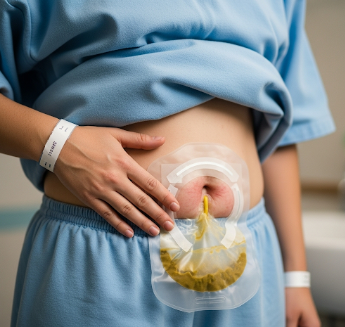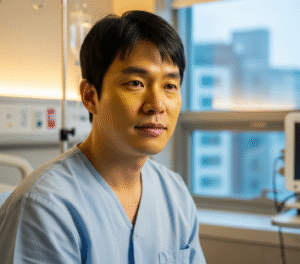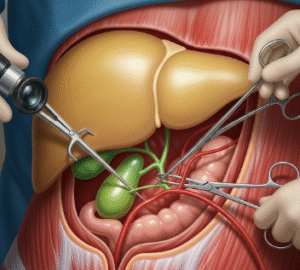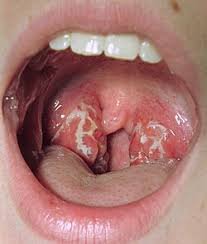Overview
A colostomy is a surgical procedure in which a portion of the colon (large intestine) is diverted through an opening in the abdominal wall (stoma) to allow feces to bypass a damaged or diseased section of the colon. This procedure may be temporary or permanent depending on the underlying medical condition.
In South Korea, colostomy surgeries are performed in state-of-the-art hospitals using advanced techniques, including minimally invasive laparoscopic methods, ensuring high success rates, reduced complications, and optimal patient care. Korean hospitals provide pre- and post-operative counseling, stoma care education, and comprehensive rehabilitation services.
What is a Colostomy?
A colostomy creates an artificial opening (stoma) to divert the flow of stool from the damaged or diseased colon. The stool is collected in a colostomy bag attached to the abdomen.
Types of colostomy include:
- Loop colostomy: A temporary stoma created to divert fecal flow during healing of the distal bowel.
- End colostomy: Permanent or temporary, formed when one end of the colon is brought to the surface.
- Double-barrel colostomy: Two stomas are created, one for stool and one for mucus drainage, often temporary.
Colostomy may be indicated for:
- Colon cancer
- Diverticulitis or severe bowel obstruction
- Trauma or injury to the colon
- Inflammatory bowel diseases (Crohn’s disease, ulcerative colitis)
What are the Benefits?
Colostomy provides life-saving and quality-of-life benefits:
✔ Diverts fecal flow from damaged or healing colon segments.
✔ Allows bowel healing after surgery, injury, or infection.
✔ Can be temporary or permanent based on patient needs.
✔ Reduces risk of complications such as obstruction, perforation, or infection.
✔ Improves quality of life in patients with colorectal diseases.
Procedure Details
1) How should I prepare for a Colostomy?
- Medical assessment: Blood tests, imaging, and colon evaluation.
- Bowel preparation: Laxatives or enemas may be required for elective procedures.
- Medication review: Adjustment of blood thinners or other medications.
- Preoperative counseling: Discussion of stoma type, procedure details, risks, and recovery.
- Stoma site marking: Performed by a stoma care nurse for optimal placement.
South Korean hospitals provide personalized preparation plans, including education on stoma care and post-operative lifestyle adjustments.
2) What happens during the Colostomy procedure?
- Surgery is performed under general anesthesia.
- The diseased portion of the colon is identified and either diverted to form a stoma or removed entirely.
- The stoma is brought through the abdominal wall, and sutures secure the colon to the skin.
- A colostomy bag is applied to collect stool.
- Surgery duration typically ranges from 1–3 hours, depending on the type and complexity.
South Korean surgeons focus on optimal stoma placement, minimal tissue trauma, and precise surgical technique.
3) What happens after a Colostomy?
- Patients are monitored in the hospital for 2–7 days depending on the procedure and recovery.
- Pain is managed with medications, and early mobility is encouraged.
- Stoma care education is provided, including bag changes, hygiene, and skin care.
- Diet may be modified initially, gradually returning to a regular regimen.
- Follow-up includes monitoring for complications such as infection, leakage, or hernia.
South Korean hospitals provide structured post-operative care, stoma training, and support groups to ensure smooth adaptation.
Risks / Benefits
Potential Risks:
- ➤ Stoma infection or skin irritation
- ➤ Bleeding
- ➤ Stoma retraction or prolapse
- ➤ Bowel obstruction
- ➤ Complications from anesthesia
Major Benefits:
- ✔ Life-saving diversion of stool in damaged or diseased colon
- ✔ Allows healing of distal bowel segments
- ✔ Improves quality of life in patients with colorectal conditions
- ✔ Minimally invasive options reduce recovery time
- ✔ Expert surgical care in South Korea ensures optimal outcomes
Recovery and Outlook
- Immediate post-op: Pain management, monitoring of vital signs, and initial stoma care.
- First week: Adaptation to stoma care and gradual resumption of light activity.
- 2–6 weeks: Most patients resume normal activities; full recovery depends on health and procedure type.
- Long-term outlook: With proper care, patients can lead normal lives, maintain nutrition, and manage bowel function effectively.
South Korean hospitals provide continuous post-operative support, dietary counseling, and long-term follow-up to optimize quality of life.
When To Call the Doctor
Contact your healthcare provider if you notice:
- ➤ Severe abdominal pain or tenderness
- ➤ Fever, chills, or signs of infection
- ➤ Stoma bleeding, leakage, or unusual discharge
- ➤ Swelling or retraction of the stoma
- ➤ Persistent nausea or vomiting
Best Korea Option / Process
South Korea is a leading destination for colostomy surgery and care due to:
- Highly skilled colorectal and general surgeons
- Minimally invasive laparoscopic techniques
- Comprehensive stoma care training and patient support
- Advanced imaging and surgical facilities
- International patient services, including translators, accommodation, and follow-up care
- Affordable treatment costs with world-class quality
Top hospitals for colostomy in Korea:
- Samsung Medical Center
- Asan Medical Center, Seoul
- Seoul National University Hospital
- Severance Hospital (Yonsei University Health System)













